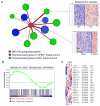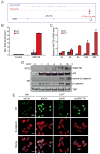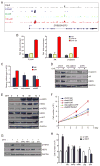Targeting androgen receptor in estrogen receptor-negative breast cancer
- PMID: 21741601
- PMCID: PMC3180861
- DOI: 10.1016/j.ccr.2011.05.026
Targeting androgen receptor in estrogen receptor-negative breast cancer
Abstract
Endocrine therapies for breast cancer that target the estrogen receptor (ER) are ineffective in the 25%-30% of cases that are ER negative (ER-). Androgen receptor (AR) is expressed in 60%-70% of breast tumors, independent of ER status. How androgens and AR regulate breast cancer growth remains largely unknown. We find that AR is enriched in ER- breast tumors that overexpress HER2. Through analysis of the AR cistrome and androgen-regulated gene expression in ER-/HER2+ breast cancers we find that AR mediates ligand-dependent activation of Wnt and HER2 signaling pathways through direct transcriptional induction of WNT7B and HER3. Specific targeting of AR, Wnt or HER2 signaling impairs androgen-stimulated tumor cell growth suggesting potential therapeutic approaches for ER-/HER2+ breast cancers.
Copyright © 2011 Elsevier Inc. All rights reserved.
Figures








Similar articles
-
Androgen Receptor Expression and Bicalutamide Antagonize Androgen Receptor Inhibit β-Catenin Transcription Complex in Estrogen Receptor-Negative Breast Cancer.Cell Physiol Biochem. 2017;43(6):2212-2225. doi: 10.1159/000484300. Epub 2017 Oct 25. Cell Physiol Biochem. 2017. PMID: 29069648
-
FOXA1 regulates androgen receptor variant activity in models of castrate-resistant prostate cancer.Oncotarget. 2015 Oct 6;6(30):29782-94. doi: 10.18632/oncotarget.4927. Oncotarget. 2015. PMID: 26336819 Free PMC article.
-
Role of the androgen receptor in breast cancer and preclinical analysis of enzalutamide.Breast Cancer Res. 2014 Jan 22;16(1):R7. doi: 10.1186/bcr3599. Breast Cancer Res. 2014. PMID: 24451109 Free PMC article.
-
Androgen receptor signaling pathways as a target for breast cancer treatment.Endocr Relat Cancer. 2016 Oct;23(10):R485-98. doi: 10.1530/ERC-16-0190. Epub 2016 Aug 15. Endocr Relat Cancer. 2016. PMID: 27528625 Review.
-
[Dual effects of androgens on mammary gland].Bull Cancer. 2008 May;95(5):495-502. doi: 10.1684/bdc.2008.0631. Bull Cancer. 2008. PMID: 18541513 Review. French.
Cited by
-
Targeting the androgen receptor in breast cancer.Curr Oncol Rep. 2015 Feb;17(2):4. doi: 10.1007/s11912-014-0427-8. Curr Oncol Rep. 2015. PMID: 25665553 Review.
-
Endosomal recycling inhibitors downregulate estrogen receptor-alpha and synergise with endocrine therapies.Breast Cancer Res Treat. 2024 Apr;204(3):631-642. doi: 10.1007/s10549-023-07225-2. Epub 2024 Jan 16. Breast Cancer Res Treat. 2024. PMID: 38228924 Free PMC article.
-
Prolactin-induced protein mediates cell invasion and regulates integrin signaling in estrogen receptor-negative breast cancer.Breast Cancer Res. 2012 Jul 20;14(4):R111. doi: 10.1186/bcr3232. Breast Cancer Res. 2012. PMID: 22817771 Free PMC article.
-
Clinical significance of serum PSA in breast cancer patients.BMC Cancer. 2019 Oct 29;19(1):1021. doi: 10.1186/s12885-019-6256-2. BMC Cancer. 2019. PMID: 31664946 Free PMC article.
-
Cancer Stem Cells and Androgen Receptor Signaling: Partners in Disease Progression.Int J Mol Sci. 2023 Oct 11;24(20):15085. doi: 10.3390/ijms242015085. Int J Mol Sci. 2023. PMID: 37894767 Free PMC article. Review.
References
-
- Agoff SN, Swanson PE, Linden H, Hawes SE, Lawton TJ. Androgen receptor expression in estrogen receptor-negative breast cancer. Immunohistochemical, clinical, and prognostic associations. Am J Clin Pathol. 2003;120:725–731. - PubMed
-
- Baselga J, Swain SM. Novel anticancer targets: revisiting ERBB2 and discovering ERBB3. Nat Rev Cancer. 2009;9:463–475. - PubMed
-
- Bonnefoi H, Potti A, Delorenzi M, Mauriac L, Campone M, Tubiana-Hulin M, Petit T, Rouanet P, Jassem J, Blot E, et al. Validation of gene signatures that predict the response of breast cancer to neoadjuvant chemotherapy: a substudy of the EORTC 10994/BIG 00-01 clinical trial. Lancet Oncol. 2007;8:1071–1078. - PubMed
Publication types
MeSH terms
Substances
Grants and funding
LinkOut - more resources
Full Text Sources
Other Literature Sources
Medical
Molecular Biology Databases
Research Materials
Miscellaneous

